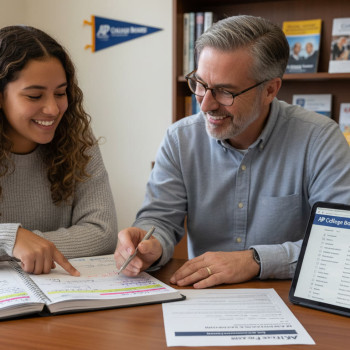Why Think of Grades 10–11 as a Bridge Year?
Jumping into your first Advanced Placement (AP) course can feel equal parts exciting and intimidating. AP classes ask you to think more deeply, read more widely, and demonstrate college-level skills in exams that matter for college credit and admissions. But what if you treated Grades 10 and 11 not just as years to survive, but as a “bridge” specifically designed to make that first AP experience smoother, more confident, and more successful? That’s the idea behind a Bridge Year Map: an intentional plan that builds the knowledge, habits, and test-taking skills you’ll need before you enroll in — and ace — your first AP.

Who this is for
This guide is for students and parents who want a realistic, practical roadmap: those aiming to take an AP course in Grade 11 or early in Grade 12, students who want to strengthen academic skills before attempting AP rigor, and parents who want to support their teens without micromanaging. It also works for motivated Grade 10 students mapping out a two-year path to readiness.
Big Picture: Three Pillars of a Successful Bridge Year
Make your bridge plan around three pillars — Content, Skills, and Strategy. Each pillar contains concrete actions that fit into classroom work, extracurricular time, and focused study sessions.
Pillar 1 — Content: Build the knowledge scaffolding
- Identify prerequisite topics: Review the AP course description for the test you plan to take and list foundational topics you can practice now (for example, algebra and functions before AP Calculus or grammar and textual analysis before AP English Language).
- Patch knowledge gaps in bite-sized chunks: Use targeted modules — a few weeks on functions, or a month on Latin roots and rhetorical devices — rather than vague “study more.”
- Leverage classroom overlap: Talk to teachers in Grades 10–11 about which lessons align with AP skills (e.g., research projects, lab reports, advanced reading). Ask for extension activities when a topic connects to AP content.
Pillar 2 — Skills: Strengthen the habits AP exams demand
- Analytical reading: Practice summarizing arguments, identifying evidence, and tracking tone. Aim for concise notes (1–3 sentences) that capture main ideas.
- Writing under time: Do timed 30–45 minute analytical essays based on short prompts. Focus on clarity, thesis-driven structure, and using textual evidence.
- Quantitative reasoning: Work short problem sets routinely—20–30 minutes, three times a week. Break complex problems into smaller steps and write each step out clearly.
- Test stamina: Simulate half-length practice sessions once a month, increasing to full-length as your AP course approaches.
Pillar 3 — Strategy: Plan your course sequence and workload
- Choose the right first AP: Pick one AP that aligns with your strengths and interests. A successful first AP builds confidence; it’s okay to start with a less intimidating course.
- Create a two-year timeline: Map topics, key mini-goals, and checkpoints. Keep the timeline flexible — the aim is steady progress, not perfection.
- Balance challenge and well-being: Don’t load up on APs before you’ve tried one. Quality beats quantity; one strong AP with good scores is better than multiple rushed attempts.
Grade-By-Grade Bridge Map: Practical Steps
The following timeline gives a realistic sequence of actions and learning goals across Grades 10 and 11. Think of these as options you adapt to your school schedule, extracurriculars, and energy.
Grade 10 — Foundations and Exploration (Summer through Spring)
Grade 10 is prime time to diagnose gaps and develop routine. You can make big returns on small weekly investments.
- Summer before Grade 10
- Do a subject audit: Pick the AP you might want and list the prerequisite knowledge. Spend 4–6 weeks doing focused review modules (math basics, grammar, lab methods, etc.).
- Try a light preview: Read a popular-level book or watch introductory lectures related to the AP subject to spark interest without pressure.
- Fall/Winter
- Build weekly micro-habits: 3 short weekly sessions (25–40 minutes) on targeted skills: analytical reading, timed writing, or problem sets.
- Join a club or competition: Debate, science fair, math team, or writing club to practice the thinking skills AP will test.
- Spring
- Take a short diagnostic: Use practice questions or a half practice test in the subject area to identify remaining weak spots.
- Meet with teachers: Ask how Grade 11 can be used to prepare for AP and request projects that mirror AP expectations.
Grade 11 — Targeted Preparation and First AP
Grade 11 is the window for your first AP. By now, you’ll move from habit-building to application and test familiarity.
- Before you enroll in an AP
- Pick the first AP based on confidence and interest. A science-minded student might start with AP Biology; a strong writer might start with AP Language or AP Literature.
- Finalize a study rhythm: weekly readings, a timed essay or problem set, and monthly practice tests.
- During the AP course
- Keep an evidence log: For essay-based courses, collect quotes, stats, and examples organized by theme. For STEM, save lab notes and worked problems.
- Regular low-stakes practice: Short quizzes and timed prompts are better for retention than cramming.
- Exam season prep
- Two months before the exam: Begin weekly full-section practice and one full-length simulation per month.
- Last three weeks: Move to weekly full-length simulations and focused review of weak areas.
Study Tools and Routines That Actually Work
Good tools are only as good as the habits that use them. Here are specific, actionable routines proven to help steady improvement without burnout.
Weekly Structure
| Day | Focus | Duration |
|---|---|---|
| Monday | Targeted content review (video or textbook) | 40 minutes |
| Wednesday | Practice problems or timed writing | 30–45 minutes |
| Friday | Active recall and spaced repetition (flashcards, quizzes) | 25–30 minutes |
| Weekend | Longer practice or project work | 60–90 minutes |
Monthly Checkpoints
- Do a mini-assessment (one practice section or one full essay). Mark three target areas to improve for the next month.
- Adjust the plan: If you consistently miss the same kind of problem, change the technique — switch from passive review to deliberate practice with step-by-step solutions.
How to Use Practice Tests Effectively (Not Just Take Them)
Practice tests are gold — but only when you analyze them carefully. Here’s a disciplined approach to turn a practice test into meaningful improvement.
- Simulate conditions: Same time allotment, quiet room, and no interruptions. This trains stamina and time management.
- Immediate review: After finishing, spend an equal amount of time reviewing mistakes. For each error, write down the root cause: content gap, careless error, or time pressure.
- Build a remediation plan: For content gaps, schedule focused review modules; for careless errors, practice accuracy drills; for time issues, practice section pacing strategies.
Parent Corner: How Parents Can Help Without Taking Over
Parents often ask how involved they should be. The best support is structure and encouragement, not rigid control.
- Create a predictable environment: Quiet study space, consistent wake/sleep times, and a reasonable curfew for screen use the night before practice tests.
- Be accountability partners: Help students set realistic weekly targets and check in briefly — a supportive 10-minute conversation works wonders.
- Celebrate progress: Small wins build momentum — improvements in practice test percentiles or consistent study streaks are worth acknowledging.
Sample Two-Year Action Plan (Compact View)
| Time | Action | Goal |
|---|---|---|
| Summer before Grade 10 | Subject audit and 4–6 week review modules | Patch major knowledge gaps |
| Grade 10 Fall/Winter | Weekly micro-habits + extra-curricular skill practice | Build habits and analytical skills |
| Grade 10 Spring | Diagnostic practice and teacher consultation | Refine choice of first AP |
| Grade 11 Year | Enroll in first AP, keep steady practice, escalate simulations before exam | Master AP pacing and content |
When to Seek Extra Help (and How to Choose It)
Some students will need extra help to build confidence or address stubborn gaps. Smart help is personalized, goal-focused, and flexible — not a generic study app or marathon tutoring with no plan.
- Signs you should get help: repeated low scores on the same skills, increasing stress that lowers performance, or a major gap in prerequisite knowledge (e.g., algebra before AP Calculus).
- What effective tutoring should offer: 1-on-1 guidance tailored to your timeline, a structured study plan with checkpoints, expert feedback on practice exams, and insights into exam strategy.
- How Sparkl’s personalized tutoring fits: Sparkl’s 1-on-1 guidance provides tailored study plans and expert tutors who focus on the specific course and your unique gaps. Their approach combines human instruction with data-driven insights so every session targets the next high-leverage improvement.
Common Pitfalls and How to Avoid Them
- Pitfall: Overloading on APs early. Avoid taking multiple APs before you’ve tested the waters. Start with one strong experience.
- Pitfall: Passive studying. Passive highlights and re-reading give the illusion of progress; switch to active recall, teaching concepts aloud, and solving fresh problems.
- Pitfall: Ignoring pacing. Many students know the content but fail to finish. Practice pacing explicitly in timed sections.
Real-World Examples: Two Student Profiles
These short sketches show how different students can use a Bridge Year Map.
Case A — Maya, the Curious Reader
Maya enjoys history and English but worries about timed essay pressure. In Grade 10 she focused on analytical reading and short timed responses, joined the debate team, and did monthly practice essays. In Grade 11 she chose AP English Language as her first AP, kept a weekly rhythm of readings and one timed essay, and used a tutor for targeted feedback on thesis development. The result: a confident AP experience and a strong portfolio of writing samples.
Case B — Jordan, the STEM Builder
Jordan loved math but struggled with algebraic manipulation early on. In Grade 10 he spent the summer strengthening algebraic fundamentals, did weekly problem-solving sessions, and participated in math club. In Grade 11 he took AP Physics 1 as his first AP with a clear study schedule: weekly problem sets, lab write-ups, and monthly practice tests. He used personalized tutoring to walk through complex problems and master exam strategy.
Final Thoughts: Make the Bridge About Growth, Not Just Scores
Thinking of Grades 10 and 11 as a Bridge Year Map turns vague anxiety into concrete steps. The aim is steady growth — building knowledge, improving skills, and developing the habits and strategies that make APs manageable. Remember: the goal is not to cram every advantage into one year, but to create a sustainable path that leads to confidence and capability when you sit down for your first AP.
Sparkl’s personalized tutoring can be an excellent addition to this plan when used thoughtfully: one-on-one guidance, tailored study plans, and expert tutors can accelerate progress on specific weaknesses. If you choose to use tutoring, treat it as a targeted tool — for focused remediation, skill sharpening, and strategy coaching — rather than a substitute for daily practice.

Quick Checklist: Start Your Bridge Today
- Choose one AP you’d like to try first and list its prerequisites.
- Set up a weekly study rhythm with three micro-sessions and one longer weekend session.
- Create monthly checkpoints with at least one timed practice and a targeted remediation plan.
- Talk to teachers about alignment and ask for extension projects tied to AP skills.
- Consider personalized tutoring for focused gaps — 1-on-1 help works best when paired with your weekly practice.
Parting Encouragement
AP success is less about talent and more about smart, consistent preparation. Use Grades 10 and 11 as your bridge, not a sprint. Build skills deliberately, practice under test conditions, and stay curious about the subjects you choose. When you reach your first AP, you’ll be ready not only to earn a score — but to truly learn. Good luck — and remember: steady steps beat frantic leaps every time.























No Comments
Leave a comment Cancel